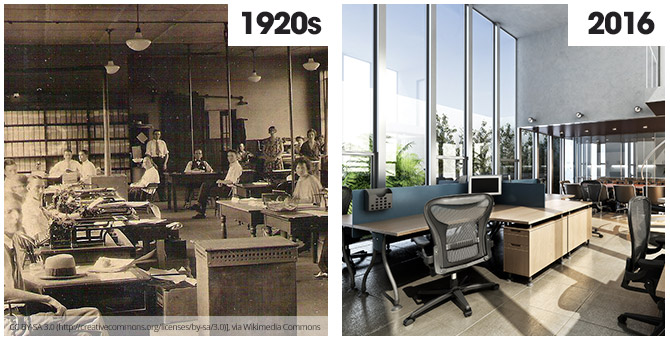Offices have changed dramatically over the years. What was once the norm in the 20th Century, swiftly became archaic in the 21st Century. Research from the Office for National Statistics said that in an average office career of 50 years, 23.3% of your total waking hours is spent at work. The office worker’s second home is the office, therefore it’s important that the environment meets requirements. So what Century has the right idea?

The Groundbreaking 20th Century
1920s – This was the beginning of a new way we looked at an office and its purpose. A pioneer of this was engineer Frederick Taylor, who helped influence American culture by introducing an open floor office plan, with all desks facing a supervisor. Somewhat reminiscent of a classroom, Taylor said this would help boost efficiency amongst the workforce.
1960s – The swinging sixties brought with it a new way of office design. Gone were the open plan offices and in came the three walled cubicle. Developed by American furniture manufacturer, Herman Miller, this new layout would help create freedom of movement and independence as you would no longer be sitting next to a co-worker a long a row of desks. In turn however, this would result in a feeling of isolation.
1980s – Many images have emerged from archives showing a much fuller and cramped feel to offices. They took a step back into the 1920s aesthetic where you worked alongside people, although in much tighter spaces. The design and layout can be still be found in call centres, where companies can create room for more staff. This however results in a feeling of enclosure and insignificance.
The Innovative 21st Century
We now live in the era of true innovation and we have turned the office template on its head. As the influx of startups appeared, so did the notion of working from anywhere. Some startup businesses have a much more relaxed atmosphere to them, with sofas, fully functional kitchens and even gaming facilities. You will rarely find smaller businesses having a hierarchical layout, where managers have their own offices. It’s more common to have managers mixing with employees, resulting in a greater sense of equality and importance.
Fluorescent Lighting and Air Conditioning
Air conditioning was introduced in the 1930s and has helped make the working environment easier to cope with. The correct temperature for offices is 21-23 degrees centigrade and it’s best to make sure that there is plenty of space to avoid air supply suffering. If the air supply suffers, then it can affect long term health.
In the 1940s, fluorescent lighting was introduced. This light source is common amongst offices due to low cost and lasting around 13 times longer than the regular incandescent bulb. By having lighting in the offices, work can be done at night, which will distract the worker from the time of day, thus boosting productivity.
Health Implications
Research from the University of Southern California found that unhappy workers take more sick days, which is an estimated 15 days every year. This impacts the UK economy greatly, as professional services network, PwC, reported that sick days cost UK employers £29 billion a year.
Technology
Offices across the globe are finding new ways to improve efficiency and wellbeing of the workforce. You now have companies that allow you to bring in your own device to use instead of the standard desktop PCs provided. This, combined with the ability of web chat, makes it easier to work from anywhere in the world and run a company from the comfort of your own home. So in this respect, offices are defined by how we work in them.
What’s the Ideal Office?
Office layouts will always become outdated as years pass. While technology evolves, so do people’s attitudes towards their work environment. People want to feel more at home while working and this vision isn’t going to change. The 20th Century was the pioneer that set the standard for decades to come. It still works in some lines of work but ultimately, the flexible office is the future.
Previous Post
Coventry’s New £50m Scheme ‘Vital’ to its Regeneration